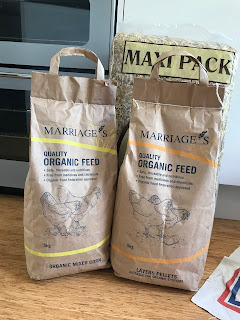Unusual edibles
Since moving down to the New Forest in Hampshire in April this year, I have been enjoying the stunning coastal scenery. One of the delicacies to be foraged in salt marsh land is Samphire. This succulent plant grows close to the ground and is known by different names in various parts of the UK. 'Poor man's asparagus' is one that comes to mind. Eaten raw it tastes a bit like a cross between spinach and sea water!!! Next time I see some I will bring some home and steam it - see if it tastes better cooked!
Matron is starting on a new venture in the new garden. I have obtained this Eglu chicken run, and in a few days' time I hope to start a new family! Exciting times ahead. Not sure yet how Daisy will take to these critters invading her garden....
I have purchased layers pellets and mixed grain for starters. I do hope they will be able to recycle kitchen waste, weeds, various slugs, snails and insects... and turn them into eggs for me!
Now here's a thing. I bought a physalis plant at a local fete. Otherwise known as Chinese lantern, golden berry or cape gooseberry, this fruit grows inside a paper lantern. I seem to remember in the past that pollination can be problematic with only one plant, and so, I managed to obtain a second plant locally so pollination should be good.
In my new greenhouse I am growing some shoots that appeared on one of my purple sweet potatoes. It may be a little late in the season to start these (they do need a longer growing season) but the warm weather here in the UK has meant they are making great progress. I have just potted them up into a larger pot in the greenhouse. Sweet potatoes are a relative of bindweed!!
I've been meaning to try this for ages. Seaweed extract is something you see on plant food labels and so I decided to see if I could make some liquid fertiliser in the same way that you make comfrey liquid. So here goes!
I collected a few bags of different types of seaweed and gave it a good wash to remove the salt. Some of this seaweed has air bladders on it to help it float in the water, so this was definitely helped with the use of a piece of concrete to weigh it down in the water.
So this will sit in a quiet corner of the garden for a few weeks to see if it will rot down to make a liquid feed. Watch this space!
P.S. I have noted with pride that many of Matron's ideas usually end up on the pages of gardening magazines, or on TV gardening programmes! I've not seen this done before, so keep your eyes peeled, and programme and magazine editors are sure to pick up on this one for an interesting topic. ;-)

























